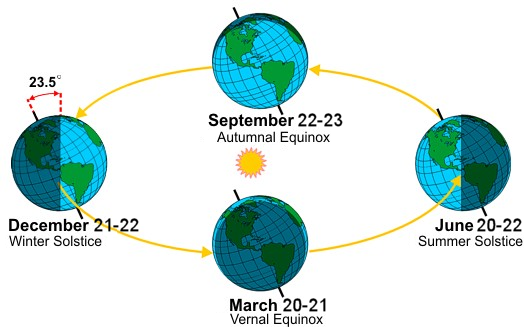Geography
Summer Solstice: 21st June
- 21 Jun 2021
- 5 min read
Why in News
21st June is the longest day in the Northern Hemisphere, technically this day is referred to as Summer solstice. In Delhi, the day length is around 14 hours.
- The amount of light received by a specific area in the Northern Hemisphere during the summer solstice depends on the latitudinal location of the place.
- 21st June is also observed as the International Yoga Day.
Key Points
- Meaning of the Word ‘Solstice’:
- It is a Latin word that means ‘stalled sun’. It is a natural phenomenon that occurs twice every year, once in the summer and again during winter, in each hemisphere of the earth - Summer and Winter Solstice.
- About Summer Solstice:

- It is the longest day and shortest night of the year in the Northern Hemisphere.
- During this, countries in the Northern Hemisphere are nearest to the Sun and the Sun shines overhead on the Tropic of Cancer (23.5° North).
- At latitudes of 23.5° are the Tropics of Cancer and Capricorn, north and south of the Equator.
- At 66.5° are the Arctic and Antarctic Circles, to the north and south.
- Latitudes are a measure of a location’s distance from the Equator.
- During the solstice, the Earth’s axis — around which the planet spins, completing one turn each day — is tilted in a way that the North Pole is tipped towards the sun and the South Pole is away from it.
- Typically, this imaginary axis passes right through the middle of the Earth from top to bottom and is always tilted at 23.5 degrees with respect to the sun.
- At the Arctic Circle, the sun never sets during the solstice.
- Greater Amount of Energy:
- This day is characterised by a greater amount of energy received from the sun. According to NASA (National Aeronautics and Space Administration), the amount of incoming energy the Earth received from the sun on this day is 30% higher at the North Pole than at the Equator.
- The maximum amount of sunlight received by the Northern Hemisphere during this time is usually on June 20, 21 or 22. In contrast, the Southern Hemisphere receives most sunlight on December 21, 22 or 23 when the northern hemisphere has its longest nights– or the winter solstice.
- Geography Behind:
- The reason behind the changing lengths of the days is the Earth’s tilt.
- The Earth’s axis of rotation is tilted at an angle of 23.5° to its orbital plane. This tilt, combined with factors such as Earth’s spin and orbit, leads to variations in the duration of sunlight, due to which any location on the planet receives different lengths of days.
- The Northern Hemisphere spends half the year tilted in the direction of the Sun, getting direct sunlight during long summer days. During the other half of the year, it tilts away from the Sun, and the days are shorter.
- The tilt is also responsible for the different seasons on Earth. This phenomenon causes the movement of the Sun from the northern to the southern hemisphere and vice versa bringing in seasonal changes in the year.
The Equinox
- Twice each year, during the equinoxes (“equal nights”), Earth's axis is not pointed toward our Sun, but is perpendicular to the incoming rays.
- It results in a "nearly" equal amount of daylight and darkness at all latitudes.
- The vernal or spring equinox occurs in the northern hemisphere on March 20 or 21. September 22 or 23 marks the northern hemisphere autumnal or fall equinox.






